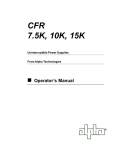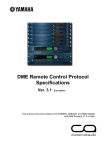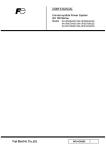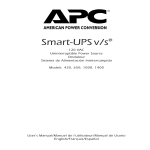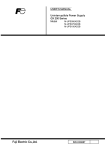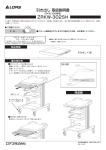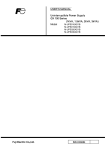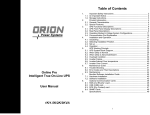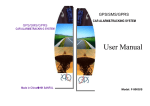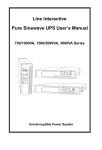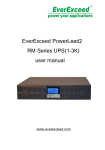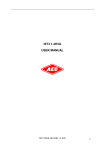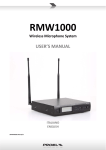Download USER`S MANUAL - Fuji Electric Corp. of America
Transcript
USER’S MANUAL Uninter r uptible Power Supply GX200 ser ies (1.5kVA, 3kVA) Model Fuji Electric Co., Ltd. M-UPS015AE2S M-UPS015AE2R M-UPS030AE2B M-UPS030AE2R M-UPS030AE2C INR-HG5980 For safe use About handling of this manual This manual contains important information for safe use of the product. Please read this manual carefully before using this product. Use this product, after reading and understanding especially “Caution about Safety" and "Caution for Use" in this manual well. Furthermore, this manual should be retained for future reference. High-safety uses This product is designed and manufactured for the general use, such as general office use and personal use, and is not designed and manufactured for uses (control of nuclear reactions at the nuclear facilities, aircraft flight control, air traffic control, mass transport control, medical life support systems, and missile launch control in weapon systems, etc.) that require a high degree of safety, and can cause death or serious injury if the required safety is not maintained. Do not use this product without carrying out measures to ensure the required safety for such a use. If using this product for such a use, consult with our sales representatives. Prevention of radio disturbance CAUTION This product is equivalent to Class A information technology device based on standards of VCCI and EN62040-2(category C2 UPS). There is a possibility where radio disturbance arises if the product is used in a home environment. The user may be requested to take appropriate measures in such a case. VCCI : Voluntary Control Council for Interference by Information Technology Product in JAPAN Prevention of harmonics current disturbance The products are based on the JIS C61000-3-2. All rights reserved. Copyright Fuji Electric Co., Ltd. 2012 Foreword An uninterruptible power system is what supplies stable electric power to OA devices, FA devices, computer devices or the like. This manual describes installation, running, daily management, troubleshooting and maintenance of an uninterruptible power system. Use an uninterruptible power supply correctly in accordance with this manual. In this manual, an uninterruptible power supply (this product) is described as UPS for short. Contents and composition of this manual The composition of this manual is shown below. Cautions for safety and use The cautions about safety are described. If you use the UPS, be sure to read this section. 1 Unpacking The cautions about taking out the UPS from a box are described. 2 Outline The name of each part and the operation mode of the UPS are described. 3 Installation Installation of the UPS and connection of the cable are described. 4 Running The methods of run and stop of the UPS are described. 5 Inspection The cautions about daily inspection and rolling blackouts are described. 6 Troubleshooting Troubleshooting is described. 7 Maintenance Replacement of battery and cooling fan and method of storage of the UPS are described. 8 Appendix Rated specification and the additional description for UL type are described. Due to the purpose to use, the chapters which should be referred to especially are as follows. For installation personnel : For users : Caution about safety, Caution for use Chapters 1, 2, 3 and 4 Caution about safety, Caution for use Chapters 2, 4, 5 and 6 For maintenance personnel : Caution about safety, Caution for use Chapters 2, 4, 5 and 7 i Foreword Warning indication In this manual, the following warning displays are described so that user or the people around the UPS do not suffer damage to the body and property. WARNING CAUTION IMPORTANT A “WARNING” sign indicates a potentially hazardous situation that could result in death or serious injury if the user does not follow instructions. A “CAUTION” sign indicates a potentially hazardous situation, which if not avoided, may result in minor injury, moderate injury or property damage. An “IMPORTANT” sign indicates matters that require attention in the use of the UPS. Symbols appearing in this manual Symbols appearing in the text of this manual are of the meanings indicated below. Describes the status of the Product. Reference to be read, if necessary. How to take actions and what to be referred to are described. LED display Indicates the LED status by any of the symbols indicated below. : Lighting : Blinking : Out Notice The description in this manual is subject to change without notice. ii Caution about safety List of important warning matters The important warning matters described in this manual are as follows. WARNING Electric shock CAUTION Electric shock Personal injury A “WARNING” sign indicates a potentially hazardous situation that could result in death or serious injury if the user does not follow instructions. Do not remove the cover from the Product. There are sections of high voltage in the Product, and electric shock may arise. A “CAUTION” sign indicates a potentially hazardous situation, which if not avoided, may result in minor injury, moderate injury or property damage. Do not stick a bar or finger into a cooling fan or ventilation hole. There is fear of an electric shock or an injury. Electric shock Only maintenance personnel must perform the maintenance other than daily inspection, such as the replacement of battery and cooling fan. There is fear of an electric shock. Connect an AC input plug to a grounding power receptacle, or connect a grounding wire to a ground terminal. (class D grounding) There is fear of an electric shock. A commercial power ordinarily has electrodes of a grounding side and an un-grounding side apart from a grounding electrode (ground). Be sure to confirm before connecting. If connected in reverse, there is fear of the malfunction by noise or the electric shock. When inspecting or maintaining the connection device (a device getting connected to the UPS) or the UPS, turn off the connection device and the UPS. And in the case of M-UPS015AE2S, pull out the AC input plug on the back of the UPS from an input power receptacle. In the case of M-UPS015AE2R and M-UPS030A2E□, turn off the input breaker in the distribution board and cut off connection with AC input terminal (R, S). There is fear of an electric shock. iii Cautions about safety and for use Injury Do not ride on or put an object on the UPS. There is fear of an injury or an overturn. Injury The UPS is heavy. Pay enough attention Injury to handling the UPS. Damage Take out the UPS in a level and flat place. Pay enough attention to prevent an accident such as an overturn or a drop. The mass of the Product is as follows. M-UPS015AE2S : 24 kg (12 kg without batteries) M-UPS015AE2R : 26 kg (14 kg without batteries) M-UPS030AE2B : 47 kg (23 kg without batteries) M-UPS030AE2R : 42 kg (18 kg without batteries) M-UPS030AE2C : 48 kg (24 kg without batteries) iv Precautions for safety Damage Do not use the UPS for the uses that may hurt the human body or exert an important influence on the society and public. Medical equipment directly affecting human life Device that may affect the human body Socially and publicly important computer systems Do not put an object (CRT display or floppy disk, etc.) vulnerable to magnetism around the UPS. There is fear of exerting a bad influence on the object. Confirm that the voltage set up by the switch of voltage setting is within the range of input voltage of the connection device. There is fear of damaging the connection device. Do not operate the switch of voltage setting during operation of the UPS. There is fear of damaging the connection device, since the changed voltage is outputted at the restart. And even if operating the switch during operation of the UPS, the output voltage cannot be changed. Replace the battery periodically. If continuing to use the UPS that the battery life ended, there is fear of a leak of battery and a smoke. Replace the battery with one specified by our company and a new one. If using the un-specified battery or mixing an old battery and a new battery, it becomes the cause of failure and trouble of the UPS. When performing the rolling blackouts or when pulling out the AC input plug from an input power receptacle or turning off the input breaker on the back of the UPS, confirm that the RUN LED (green) is blinking slowly (in the cycles of approximately 1.6 sec.). If the breaker of the distribution board is turned off or the AC input plug is pulled out from an input power receptacle, when the RUN LED is lighting, the internal battery will be discharged, since it will be in the same state as a power failure. There is fear of the battery deterioration or a shortening of a cycle of battery replacement. Warning label A warning label is attached to the Product. Never remove this warning label from the Product. This warning label is targeted to the person who uses the Product. v Cautions for use Pay attention to the following matters in the use of the Product. IMPORTANT “Important” indicates caution about the use of the UPS. Do not install and store the UPS in the following places: In an outdoor location A place exposed to the elements An extremely humid place and a dusty place A place with corrosive gas or salinity A place subjected to direct sunlight A place near sparks or heating element An extremely hot or cold place or place where the temperature fluctuates greatly A place where vibration and a shock are added Do not perform the battery check in succession. When the battery check is performed, the internal battery is actually discharged and the voltage is checked. If the battery check is performed in succession, there is fear of the battery deterioration or a shortening of a cycle of battery replacement. If the UPS is not used for a long time, charge the battery every two months. Charge the battery by operating the UPS 12 hours or more every two months, and after charging the battery, perform the battery check. If the UPS is left without operating for a long time, there is a possibility that the UPS get unusable since the battery becomes an over-discharge state due to self-discharge. The disposal of used battery has legal restrictions. Commission industrial waste disposal contractor, or consult with an agent from which you purchased the UPS, or a maintenance company. Do not block the vent hole and cooling fan or use the UPS in a stuffy place. The vent hole and cooling fan are equipped in order to cool the inside of the UPS. There is a possibility that the inside and ambient temperature of the UPS may get out of the rated specification. The UPS may rise temperature to a level that causes UPS failure or breakage. Replace the cooling fan periodically. If continuing to use the UPS that the fan life ended, there is a possibility that the inside temperature of the UPS may get out of the rated specification. Do not use 5 to 9 of the switch of voltage setting. It becomes impossible for the UPS to start up normally vi Contents The allowable voltage between the input line and grounding terminal of the Product is 250V AC. The filter circuit in the input unit may be damaged, if a voltage that is higher than 250V AC is impressed. The input surge voltage capacity of the UPS is 2 kV peak (1.2 50 sec). The filter circuit in the input unit may be damaged, if a surge voltage that is higher than 2 kV peak is impressed. The input voltage range of the UPS is from 160Vac to 288Vac.(tolerance) If the input voltage is different from the above, provide a transformer for voltage conversion outside of the Product. The UPS may be damaged, if a voltage outside of the input voltage range is impressed. The input voltage of the UPS should not exceed the input voltage range of connected equipment. During bypass running, the input voltage to the UPS is output as it is as the output voltage. The connected equipment may be damaged, if a voltage that exceeds the input voltage range of connected equipment is impressed. Do not apply single-line grounding on the output side. Between the input and output of the UPS is not insulated. Therefore, do not apply single-line grounding on the output side. There is a possibility of becoming the cause of the trouble by noise or the failure. When connecting the UPS to a three-phase power supply system, be sure to connect the grounding phase of the three-phase power supply system to the electrode of a grounding side of the AC input of the UPS. If connecting to an un-grounding power supply, there is a possibility of becoming the cause of the malfunction. When using a generator temporarily during the rolling blackouts, use a generator satisfying the following specification. If connecting a generator not satisfying the following specification to the input part of the UPS, there is a possibility of becoming the cause of the malfunction or damage of the UPS. Voltage range: from 160Vac to 288Vac Frequency variation: within 5% of rated frequency (less than 1Hz per second) Voltage waveform distortion: 5% or less Voltage zero-cross condition: No multiple zero-cross during a cycle Invalid zero-cross 50 Hz or 60 Hz vii Cautions about safety and for use Contents 1 2 3 4 5 Foreword.................................................................................................................................... i Caution about safety.............................................................................................................. iii Cautions for use..................................................................................................................... vi Unpacking ............................................................................................................................. 1 1.1 Open the package........................................................................................................... 1 Open the package........................................................................................................... 1 Check what are contained in the case.............................................................................. 1 Overview............................................................................................................................... 2 2.1 Names and principal functions of components................................................................ 2 2.2 Setup of the Product....................................................................................................... 5 During normal running................................................................................................... 5 During battery running (case of input power supply error) .............................................. 5 Automatic bypass running.............................................................................................. 6 Manual bypass running .................................................................................................. 6 Installation............................................................................................................................. 7 3.1 Installation of the Product .............................................................................................. 7 Precautions for installation ............................................................................................. 7 Determine the place of installation ................................................................................. 7 Method for installation................................................................................................... 9 3.2 Connection of cables .................................................................................................... 12 Caution about connecting the cable .............................................................................. 12 Preparation before connection ...................................................................................... 13 Connecting the output cable ......................................................................................... 15 Connecting the input cable ........................................................................................... 15 3.3 Interface port ............................................................................................................... 16 CN1 (standard monitoring interface) ............................................................................ 16 CN2 (PC interface) ...................................................................................................... 17 3.4 Setting up the Output Voltage ...................................................................................... 18 Running............................................................................................................................... 20 4.1 Power ON .................................................................................................................... 20 Check cable connection................................................................................................ 20 Turn ON the power for the Product .............................................................................. 21 Turn ON the power for connected equipment ............................................................... 22 4.2 Power OFF .................................................................................................................. 23 Turn OFF the power for the connected equipment ........................................................ 23 Turn OFF the power for the Product ............................................................................. 23 Inspection............................................................................................................................ 25 5.1 Care and daily inspection ............................................................................................. 25 Care............................................................................................................................. 26 Daily inspection ........................................................................................................... 26 5.2 Precautions and measures for planned interruption of power supply ............................. 27 Operation before implementation of planned interruption of power supply ................... 27 Operation after planned interruption of power supply ................................................... 28 5.3 Battery inspection (battery check) ................................................................................ 29 Check conditions of the Product ................................................................................... 29 Use the manual battery check function ......................................................................... 30 Charge batteries ........................................................................................................... 31 Charge batteries ........................................................................................................... 32 viii Contents 6 Troubleshooting................................................................................................................... 33 6.1 If a Warning Beep Sounds............................................................................................ 33 6.2 Operation Mode List .................................................................................................... 34 Types of blink of LED.................................................................................................. 34 Types of the warning beep ............................................................................................ 34 List of motion modes.................................................................................................... 35 7 Maintenance ........................................................................................................................ 39 7.1 Battery replacement ..................................................................................................... 39 Time of battery replacement ......................................................................................... 39 Method for battery replacement .................................................................................... 40 Battery treatment and storage ....................................................................................... 41 7.2 Cooling fan replacement............................................................................................... 42 Time of cooling fan replacement .................................................................................. 42 Method for cooling fan replacement ............................................................................. 43 7.3 Storage of the Product .................................................................................................. 44 Operations before storage............................................................................................. 44 Case where storage period exceeds 2 months................................................................ 44 8 Appendix............................................................................................................................. 45 8.1 Rated specification ....................................................................................................... 45 8.2 Additional Description for UL Type ............................................................................. 47 ix 1 Unpacking 1.1 Open the package Open the package CAUTION Injury The UPS is heavy. Pay enough attention Injury to handling the UPS. Damage Take out the UPS in a level and flat place. Pay enough attention to prevent an accident such as an overturn or a drop. The mass of the Product refer to “Caution about Safety”. 1. Open the packing box and take out the UPS. Check what are contained in the case 2. Confirm that there is no damage in the appearance of the UPS. 3. Confirm that all accessories are contained. Product type M-UPS015AE2S M-UPS015AE2R M-UPS030AE2B M-UPS030AE2R M-UPS030AE2C Accessory Instruction manual (this manual) Guarantee (this manual) Cord plug for Inlet Cord plug for Outlet Instruction manual (this manual) Guarantee (this manual) Rack mount rails for right side and left side Screws for rack mount rail fixation Washers for rack mount rail fixation Instruction manual (this manual) Guarantee (this manual) Stabilizer (with 6 setscrews) Instruction manual (this manual) Guarantee (this manual) Rack mount rails for right side and left side Screws for rack mount rail fixation Washers for rack mount rail fixation Instruction manual (this manual) Guarantee (this manual) L-type Bracket (with 4 setscrews) If damaged, or any of accessories is missing: Please contact your sales representative. -1- Quantity 1 copy 1 set 1 set 1 copy 1 set 10 set 8 set 1 copy 1 set 1 copy 1 set 10 set 8 set 1 copy 1 set 2 Overview 2.1 Names and principal functions of components The names and principal functions of components of the Product are described below. <M-UPS015AE2S> ⑥ ① ⑩ ② ⑦ ⑱ ③ ⑳ ④ ⑲ ⑭ ⑤ ⑧ ⑪ ⑨ <M-UPS015AE2R, M-UPS030AE2R> ⑤ ④ ⑧ ③ ⑦ ② ① ⑥ ⑨ ⑱ ⑩ ⑬ -2- ⑫ ⑰’ ⑯ ⑲ ⑳ ⑰ ⑬ 2.2 Setup of the Product <M-UPS030AE2B, M-UPS030AE2C> ⑥ ① ② ⑦ ③ ④ ⑤ ⑧ ⑲ ⑩ ⑱ ⑮ ⑳ ⑬ ⑯ ⑫ ⑰ ⑰’ -3- 2 Overview Name ① RUN ② LED ③ ALARM OVER LOAD BYPASS ⑤ BATTERY CONDITION ⑥ ON/OFF ⑦ RESET ⑧ Switch ④ BATT CHECK BYPASS ⑨ ⑩ ⑪ ⑫ ⑬ ⑭ ⑯ ⑰ ⑰’ ⑱ ⑲ ⑳ Ventilation hole (Air suction) Cooling fan AC inlet (only M-UPS015AE2S) Input terminal block (except M-UPS015AE2S) Input supplementary protector AC outlet (only M-UPS015AE2S) Output terminal block (except M-UPS015AE2S) Ground terminal Ground terminal Switch of voltage setting Standard monitoring interface (CN1) PC interface (CN2) Principal function It blinks (green) when the UPS is connected to an input power supply. It lights up (green) while the UPS is operating normally. It lights up (orange) when the abnormalities occurred inside the UPS. It lights up (orange) when the load capacity of the connection device exceeded the rated specification. It lights up (orange) while the UPS is performing the bypass operation. When the battery is normal, it indicates the amount of battery charge according to the sort (not lighting/blinking/lighting) of lighting (green). When the battery is abnormal, it lights up (orange). It is the switch for performing operation and stop of the UPS. RUN and STOP are switched every time this switch is pressed for approximately 1 second. Press this switch when stopping the warning beep. Also, if this switch is pressed for approximately 3 seconds after the failure is restored, theALARM LED goes out. It is the switch for performing the battery check manually. By pressing the switch for approximately 2 seconds, the battery check is performed. Press switch ⑦ and ⑧ for approximately 3 seconds simultaneously when switching to the bypass operation forcibly (manually) while the UPS is operating normally. When the switches are pressed for approximately 3 seconds simultaneously again, the UPS returns to the normal operation. The inside of the UPS is ventilated. The direction of air is intake. The inside of the UPS is cooled. The direction of air is exhaust. Connect to an input power supply (IEC60320-1 C14) Connect to an input power supply. It is the breaker for protecting the input circuit. Connect the input plug of the connection device. (IEC60320-1 C13) Connect to an output system. P.E. (Protect Earth) F.G. (Functional ground) Set up the output voltage Output a no-voltage contact signal. It is a computer interface. -4- 2.2 Setup of the Product 2.2 Setup of the Product During normal running The Product runs using AC power supply as the input during normal running, and feeds a constant voltage output to the connected equipment. At the same time, the Product charges batteries located in the Product, in preparation for battery running. The output frequency is synchronized with the input frequency. The Product Bypass AC/AC converter Step-up chopper Charger : Electricity is flowing Batteries : Electricity is not flowing Output to connected equipment Input power supply Flow of electricity during normal running During battery running (case of input power supply error) If any input power supply error such as interruption of input power supply and voltage or frequency error arises while the Product is running, discharge from batteries begins and stable power is kept supplied to the load. Switching to battery running occurs uninterruptibly. Return to running described in “ During normal running” stated above occurs automatically upon recovery of the AC input power supply (the voltage of input power supply returns to the rated specification). The Product Bypass AC/AC converter Step-up chopper Charger Occurrence of input power supply error : Electricity is flowing Batteries : Electricity is not flowing Output to connected equipment Such as “voltage error,” “frequency error” during normal running of the Product Flow of electricity during battery running -5- 2.2 Setup of the Product Automatic bypass running If any error occurs to the Product during normal running, switching to bypass running occurs automatically. During bypass running, input voltage is directly fed and power is supplied to the connected equipment. If interruption of power supply arises in this running status, switching to battery running will not occur and interruption of power supply will affect the connected equipment. The Product Bypass AC/AC converter Occurrence of error to the Product Charger : Electricity is flowing Batteries : Electricity is not flowing Output to connected equipment Input power supply Failure in the Product Flow of electricity during automatic bypass running Manual bypass running Switching to bypass running can be executed manually during normal running. For this operation, press the RESET and BATT CHECK switch simultaneously for about 3 seconds. Return to normal running occurs when both of these switches are pressed simultaneously for about 3 seconds. If interruption of power supply arises in this running status, switching to battery running will not occur and interruption of power supply will affect the connected equipment. The Product Bypass AC/AC converter Step-up chopper Charger : Electricity is flowing Batteries Input power supply : Electricity is not flowing Output to connected equipment Manual switching to bypass running Flow of electricity during manual bypass running -6- 3 Installation 3.1 Installation of the Product Precautions for installation CAUTION Injury Do not ride on or put an object on the UPS. There is fear of an injury or an overturn. Damage Do not put an object (CRT display or floppy disk, etc.) vulnerable to magnetism around the UPS. There is fear of exerting a bad influence on the object. Determine the place of installation IMPORTANT Do not install and store the UPS in the following places: In an outdoor location A place exposed to the elements An extremely humid place and a dusty place A place with corrosive gas or salinity A place subjected to direct sunlight A place near sparks or heating element An extremely hot or cold place or place where the temperature fluctuates greatly A place where vibration and a shock are added Do not use the UPS in a residential area or its neighborhood. This UPS is equivalent to Class A information technology device based on standards of Voluntary Control Council for Interference by Information Technology Product (VCCI). There is a possibility where radio disturbance arises if the product is used in a home environment. The user may be requested to take appropriate measures in such a case. Do not block the vent hole and cooling fan or use the UPS in a stuffy place. The vent hole and cooling fan are equipped in order to cool the inside of the UPS. There is a possibility that the inside and ambient temperature of the UPS may get out of the rated specification. The UPS may rise temperature to a level that causes UPS failure or breakage. -7- 3 Installation The following spaces are required for an installation location. The UPS takes in air through the vent hole on the front of the UPS and exhausts air through the cooling fan on the back of the UPS. Therefore, the space of 10cm or more is required in the front and rear of the UPS. Front face Back face Exhaust Air intake Product main unit 10 cm or more 10 cm or more When performing maintenance of the UPS: The space of approximately 1m is required in the front and rear of the UPS. Space for maintenance of cooling fan Space for maintenance of cooling fan/batteries Approx. 1m Approx. 1m Back face Front face UPS main unit Confirm the environment of the installation location. The recommended environment in consideration of the battery life, etc. is as follows. Item Temperature Humidity Recommended environment 15 to 25 C 30 to 70% (No condensation) -8- 3.1 Installation of the Product Method for installation CAUTION Injury This UPS can be installed laying down. If installing laying the UPS down, tilt it only to the right side, seeing from the front. Never tilt the UPS to the left side. Damage Take out the UPS in a level and flat place. Pay enough attention to prevent an accident such as an overturn or a drop. The mass of the UPS refers to “Caution about Safety”. M-UPS015AE2S and M-UPS030AE2B can be installed lying down. If install laying down the UPS, tilt it only to the right side, seeing from the front. Never tilt the UPS to the left side. <M-UPS030AE2B> For preventing an overturn of the UPS, the UPS fixes to a floor with an attached stabilizer and screws. (1) Tilt the UPS gently to the right and attach the bracket to the bottom of the UPS with 6 screws. (2) Fixed the stabilizer to a floor with an anchor bolt. (Please prepare the anchor bolt by a user.) stabilizer 4 anchor bolts 6 screws -9- 3 Installation <M-UPS030AE2C> For preventing an overturn of the UPS, the UPS fixes to a floor with an attached L-type bracket and screws. (1)Fix the L-type brackets (right side and left side) to the UPS with 4 screws (2)Fixed the L-type brackets to a floor with an anchor bolt. (Please prepare the anchor bolt by a user.) 4 anchor bolts 4 screws L-type bracket L-type bracket <M-UPS015AE2R / M-UPS030AE2R> 1.Loosen the screw of the right rail for rack mounting ① and the left rail for rack mounting ②, and adjust the length of each rail to the length of the rack. The length of the rail can be adjusted from 565 mm to 764 mm. Tighten the screw after adjusting the length of each rail. - 10 - 3.1 Installation of the Product 2.To match the position of each rail, set the washers for positioning ④ in the corner hole of the rack respectively (four places of each rail). Then, fix the rail with the screws for rack mounting ③ in the place of the corner hole with the washers. Set up the bending part in the rail to the lower side and inside. (The washers might become unnecessary by the kind of the rack.) ④ Enlargement 拡大図 ③ ② ② ① ③ ③ ③ ① The figure which looked ラックを正面から見た図 at the rack from the front ③ The figure which looked ラックを背面から見た図 at the rack from the back 3.Put the system on the rail, and fix the right and left in the front side part with screws for rack mounting ③. ① ③ - 11 - 3 Installation 3.2 Connection of cables Caution about connecting the cable CAUTION Electric shock Connect an AC input plug to a grounding power receptacle, or connect a grounding wire to a ground terminal. (class D grounding) There is fear of an electric shock. A commercial power ordinarily has electrodes of a grounding side and an un-grounding side apart from a grounding electrode (ground). Be sure to confirm before connecting. If connected in reverse, there is fear of the malfunction by noise or the electric shock. IMPORTANT The permissible voltage between the input electric cable of the UPS and the ground is 250 VAC. If the voltage more than 250 VAC is applied, the filter circuit of the input part may be damaged. The input surge voltage capacity of the UPS is 2 kV peak (1.2 50 sec). The filter circuit in the input unit may be damaged, if a surge voltage that is higher than 2 kV peak is impressed. The input voltage range of the UPS is from 160Vac to 288Vac.(tolerance) If the input voltage is different from the above, provide a transformer for voltage conversion outside of the Product. The UPS may be damaged, if a voltage outside of the input voltage range is impressed. Connect the UPS to an input power supply within the range of the rated input voltage of the connection device. At the bypass operation, the input voltage of the UPS is outputted to the connection device directly. If the voltage more than the range of the rated input voltage of the connection device is applied, the connection device may be damaged. Do not apply single-line grounding on the output side. Between the input and output of the UPS is not insulated. Therefore, do not apply single-line grounding on the output side. There is a possibility of becoming the cause of the trouble by noise or the failure. - 12 - 3.2 Connection of cables Preparation before connection IMPORTANT When connecting the UPS to a three-phase power supply system, be sure to connect the grounding phase of the three-phase power supply system to the electrode of a grounding side of the AC input of the UPS. If connecting to an un-grounding power supply, there is a possibility of becoming the cause of the malfunction. When using a generator temporarily during the rolling blackouts, use a generator satisfying the following specification. If connecting a generator not satisfying the following specification to the input part of the UPS, there is a possibility of becoming the cause of the malfunction or damage of the UPS. Voltage range:: from 160Vac to 288Vac Frequency variation: within 5% of rated frequency (less than 1Hz per second) Voltage waveform distortion: 5% or less Voltage zero-cross condition: No multiple zero-cross during a cycle Invalid zero-cross 50 Hz or 60 Hz 1. Check the input power supply. The input power supply that may be connected to the Product is as follows. Product type M-UPS015 AE2S M-UPS015 AE2R M-UPS030 AE2B M-UPS030 AE2R M-UPS030 AE2C Circuit breaker capacity 10 A or greater Input capacity Input voltage Number of phases 50/60 Hz 5% (See note.) Single phase, 2-wire system 1.5kVA or greater 160V to 288VAC 20 A or greater Input frequency 3 kVA or greater Remarks: The Product may reach the state described below or failure may arise to the Product, if the input voltage or frequency is deviated out of this range. When the power for the Product is ON: “input error at start-up” arises. The Product cannot be started in this state. - 13 - 3 Installation While the Product is running: “Input voltage error” is detected, and the running status changes to battery running. If the Product is connected to input power supply that frequently deviates from this range, charge/discharge of batteries is repeated, and battery “empty” state arises or deterioration of batteries may result. Be cautious. Note: An input frequency is automatically chosen according to the area in which the Product is used. 2. The terminal block specification is as follows. Select conforming crimp-style terminals and the input/output cable size with reference to the following table. UPS side Specification Terminal symbol L/R Input/output terminal block N/S GND (FG) l/U n/V Protective Earth terminal PE (G) Connect with Connection to Form AC input (non-grounded side terminal) AC input (Grounded side terminal) Ground 5P screw terminal (M4) AC output (non-grounded side terminal) AC output (grounded side terminal) Ground (protective earth) (M4) Input power supply and output system Grounding conductor 3. The specifications of the AC input plug and AC outlet of M-UPS015AE2S is as follows. Prepare an input power receptacle and the plug of connection device which are suitable for specification. UPS side AC input plug AC outlet Specification IEC60320-C14 (the length of a cord : approximately 2m) IEC60320-C13 x 8 (Rating capacity 250VAC, 10A) Connect with Input power receptacle Plug of connection device If there is no ground in an input power receptacle: Connect the grounding wire to the ground terminal of AC input plug. - 14 - 3.2 Connection of cables Connecting the output cable 1. In the case of M-UPS015AE2S, connect the plug of connection device to the AC outlet out the back of the UPS. Confirm that the ground is connected. 2. In the case of M-UPS015AE2R and M-UPS030AE2, remove the AC input/output terminal block cover from the back face of the UPS, and connect the AC output cable to the AC output terminal block. Confirm that the ground is connected. Connecting the input cable 1. In the case of M-UPS015AE2S, connect the AC input plug on the back of the UPS to an input power receptacle. Confirm that the ground is connected. 2. In the case of M-UPS015AE2R and M-UPS030AE2□, remove the AC input/output terminal block cover from the back face of the UPS, and connect the AC input cable to the AC input terminal block. Confirm that the ground is connected. - 15 - Installation 3.3 Interface port The Product is provided with a D-sub 9-pin interface port on its back face, and this interface port permits take-out of signals indicated below. Use these signals as required. CN1 (standard monitoring interface) D-sub 9-pin male port (3 mm threads) Pin No. 1-4 Signal type “Opens” on action 1-6 “Closes” on action 2-5 “Opens” on action 2-7 “Closes” on action 3-9 “Opens” on action 3-8 “Closes” on action Signal name Description Product failure signal No-voltage contact signal that is output when any failure arises in the Product, and any error arises to batteries or when the battery replacement recommended time comes. Input power supply error signal No-voltage contact signal that is output when any voltage error arises to the input power supply due to interruption of power supply or the like. (No action will occur, if the power supply error is of up to 1.5 seconds.) Low battery voltage signal No-voltage contact signal that is output about 2 minutes (during rated load) before termination of battery discharge during battery running. Use the contact output in the voltage and current ranges indicated below. AC contact rating DC contact rating Contact current (A) 3 Contact voltage [V] - 16 - 3.2 Connection of cables CN2 (PC interface) D-sub 9-pin female port (#4-40 inch threads) Pin No. Signal type Signal name Description No-voltage contact signal that is output when Input power any voltage error arises to the input power “Closes” on supply error 2-3 supply due to interruption of power supply or action signal the like. (No action will occur, if the power (See Note 1.) supply error is of up to 1.5 seconds.) No-voltage contact signal that is output about Low battery “Closes” on 2 minutes (during rated load) before 1-3 voltage signal action termination of battery discharge during (See Note 1.) battery running. Signal input to the Product for stopping AC UPS AC output output from the Product. automatic stops upon (1) AC output may be stopped only during 8-7 shutdown receipt of battery running. signal “H” signal (2) This signal (5 to 25 V DC) should be (See Note 2.) input for about 0.6 second or longer. Serial data <Communication method> 6-7 input (RX) Baud rate: 2400 bps RS-232C Data length: 8 bits Serial data serial signal 9-7 Stop bit: 1 bit output (TX) (See Note 3.) Parity: non Signal ground 7 Character type: ASCII type (SG) Note 1: See the graph on the previous page for contact capacity. In case the UPS monitor function (using contact signals stated above) that is mounted as default in the following OS is used, a dedicated contact signal cable that corresponds to the OS is required elsewhere. Therefore, please contact the in-charge maintenance staff. For details of the UPS monitor function that is mounted as default in each OS, see the instruction manual and online manual for the OS. Windows NT/2000/XP: FiFH/WS9 (dedicated contact signal cable) Note 2: Windows 2000 and XP permit shutdown of the OS on occurrence of interruption of power supply, and UPS automatic shutdown thereafter is not feasible. Note 3: Dedicated RS-232C communication cable is required elsewhere for execution of RS-232C serial communication. Please contact the in-charge maintenance staff. FiFA/WS9 (dedicated RS-232C communication cable) - 17 - 3 Installation 3.4 Setting up the Output Voltage This UPS can change the rated output voltage by the switch of voltage setting on the back of the UPS. CAUTION Damage Confirm that the voltage set up by the switch of voltage setting is within the range of input voltage of the connection device. There is fear of damaging the connection device. Do not operate the switch of voltage setting during operation of the UPS. There is fear of damaging the connection device, since the changed voltage is outputted at the restart. And even if operating the switch during operation of the UPS, the output voltage cannot be changed. IMPORTANT Do not use 5 to 9 of the switch of voltage setting. It becomes impossible for the UPS to start up normally The setup procedures of the rated output voltage 1. Turn off the connection device. 2. Press the RUN/STOP switch on the front of the UPS for approximately 1 second. The buzzer will sound if the switch is received. 3. An output stops.The RUN LED (green) on the front of the UPS blinks slowly (in the cycles of approximately 1.6 sec.). 4. In the case of M-UPS015AE2S, pull out the AC input plug on the back of the UPS from an input power receptacle. 5. In the case of M-UPS015AE2R and M-UPS030AE2□, turn off the breaker of the distribution board. 6. After confirming that all LEDs on the front of the UPS have gone out, operate the switch of voltage setting on the back of the UPS. The rated output voltage corresponding to a setup of the switch of voltage setting is shown below. Setup of the switch of voltage setting Rated output voltage 0 200 VAC 1 208 VAC 2 220 VAC 3 230 VAC 4 240 VAC 5-9 They are not used. - 18 - 3.2 Connection of cables 7. In the case of M-UPS015AE2S, connect the AC input plug on the back of the UPS to an input power receptacle. In the case of M-UPS015AE2R and M-UPS030AD2□, turn on the breaker on the distribution board. For M-UPS030AE2□, turn on the input breaker on the back of the UPS. The RUN LED (green) on the front of the UPS blinks slowly (in the cycles of approximately 1.6 sec.). 8. Press the RUN/STOP switch on the front of the UPS for approximately 1 second. The buzzer will sound if the switch is received. 9. AC voltage set up is outputted from the AC outlet or the output terminal block. The RUN LED (green) on the front of the UPS lights up. 10. Turn on the connection device, if the normal operation is started with the rated voltage set up. - 19 - 4 4.1 Running Power ON CAUTION Damage Confirm that the voltage set up by the switch of voltage setting is within the range of input voltage of the connection device. There is fear of damaging the connection device. Check cable connection 1. Confirm that the UPS is connected to an input power supply and the connection device. The RUN LED (green) on the front of the UPS blinks slowly (in the cycles of approximately 1.6 sec.). If the UPS is not connected: Refer to Chapter 3.2 “Connecting the Cable”. - 20 - 4.1 Power ON Turning on the UPS 2. Press the RUN/STOP switch on the front of the UPS for approximately 1 second. The buzzer will sound if the switch is received. Press the RUN/STOP switch for approximately 1 second. 3. AC voltage is output from the AC outlet or the output terminal block. The RUN LED (green) on the front face of the Product lights up. The BATTERY CONDITON LED (green) on the front face of the UPS indicates the extent of battery charge by the lighting type. Lighting RUN LED Battery charge Lighting : 80 to 100% Blinking : 50 to 80% off : under 50% - 21 - 4 Running 4. The battery check is performed automatically.The BATTERY CONDITION LED (orange) on the front of the UPS blinks (in the cycles of approximately 1.6 sec.). 5. The battery check is performed for approximately 5 seconds. Then, if the battery is normal, the BATTERY CONDITION LED (green) on the front of the UPS indicates the amount of battery charge again, and the UPS returns to the normal operation. If normal running is not started: Refer to Chapter 6 “Troubleshooting”. Turn ON the power for connected equipment 6. Turn on the connection device if the normal operation is started. - 22 - 4.1 Power ON 4.2 Power OFF Make sure to perform the operation described below also in case of implementation of planned interruption of power supply. (See “5.2 Precautions and measures for planned interruption of power supply” for details.) CAUTION Damage At the occasion of OFF of the input circuit breaker on the back side of the Product, assure that the RUN LED (green) is slowly blinking (in about 1.6-second period). If the circuit breaker of the distribution board is turned OFF, or the input circuit breaker on the back side of the Product is OFF without execution of the operation described in “ Turn OFF the power for the Product” below, conditions that are identical to those in the state of interruption of power supply arise, and therefore, discharge from batteries located in the Product begins. Damage to batteries and shortening of battery replacement period may arise otherwise. Turn OFF the power for the connected equipment 1. Turn OFF the power for the connected equipment Turn OFF the power for the Product 2. Press the ON/OFF switch on the front face of the Product for about one second. The buzzer begins to beep upon acceptance of the switch. Press the ON/OFF switch for one second. - 23 - 4 Running 3. The output stops. The RUN LED (green) on the front face of the Product blinks slowly (in about 1.6-second period). If the output fails to stop normally: See “Chapter 6 Troubleshooting”. 4. Turn OFF the input circuit breaker of distribution board. - 24 - 5 Inspection 5.1 Care and daily inspection It is essential to implement care and inspection described below, to keep using the Product without anxiety over an extended period of time, WARNING Electric shock Do not remove the cover from the Product. There are sections of high voltage in the Product, and electric shock may arise. CAUTION Electric shock At the occasion of inspection and maintenance of the Product, turn OFF the power for the connected equipment and the Product, turn OFF the input circuit breaker on the back side of the Product, and disconnect cables from AC input terminals (L/R, N/S). Electric shock may result otherwise. It is requested that maintenance (such as replacement of batteries and replacement of cooling fans) other than daily inspection is executed by professional engineers. Electric shock may result otherwise. Damage At the occasion of OFF of the input circuit breaker on the back side of the Product, assure that the RUN LED (green) is slowly blinking (in about 1.6-second period). If the circuit breaker of a distribution board is turned OFF, or the input circuit breaker on the back side of the Product is OFF without execution of the operation described in “4.2 Power OFF”, conditions that are identical to those in the state of interruption of power supply arise, and therefore, discharge from batteries located in the Product begins. Damage to batteries and shortening of battery replacement period may arise otherwise. - 25 - 5 Inspection Care 1. Turn OFF the power for the connected equipment and then turn OFF the power for the Product. Then remove dust from ventilation holes and cooling fans of the Product with a vacuum cleaner or the like. 2. Rub surfaces of the Product with a soft dry cloth. Daily inspection Assure that ventilation holes and cooling fans are free of dust attachment. If dust is attached: See “ Care”. Assure that the Product surfaces, cables and power outlet are not abnormally heated. If abnormally heated: Check the situation and contact your dealer or the maintenance in-charge company. Assure that major abnormal noise and abnormal odor are not produced during running. If any abnormality is arising: Check the situation and contact your dealer or the maintenance in-charge company. - 26 - 5.2 Precautions and measures for planned interruption of power supply 5.2 Precautions and measures for planned interruption of power supply IMPORTANT In case a generator is used temporarily for planned interruption of power supply, use a generator that satisfies the following specification. If a generator that does not satisfy the following specification is connected to the input unit of the Product, malfunction and damage to the Product may result. Voltage range:: from 160Vac to 288Vac Frequency variation: within 5% of rated frequency (less than 1Hz per second) Voltage waveform distortion: 5% or less Voltage zero-cross condition: No multiple zero-cross during a cycle Invalid zero-cross 50 Hz or 60 Hz Operation before implementation of planned interruption of power supply Turn OFF the power for the connected equipment and the Product before implementation of planned interruption of power supply (see note). 1. Turn OFF the power for the connected equipment. 2. Press the ON/OFF switch on the front face of the Product for about one second. The buzzer begins to beep upon acceptance of the switch. 3. The output stops. The RUN LED (green) on the front face of the Product begins to blink slowly (in about 1.6-second period). In case planned interruption of power supply was implemented without turning OFF the power for the Product, conditions that are identical to those in the state of interruption of power supply arise, and power is fed to the connected equipment from batteries in the Product until power recovery (termination of planned interruption of power supply). On termination of discharge, therefore, power feed to the connected equipment will not be implemented until power recovery arises. Note: Planned interruption of power supply means interruption of power supply, the date and hour of occurrence of which is known in advance for electricity safety checkup or the like. - 27 - 5 Inspection Operation after planned interruption of power supply 1. Assure that the Product is connected to the input power supply and connected equipment. The RUN LED (green) on the front face of the Product begins slowly blinking (in about 1.6-second period). 2. Press the ON/OFF switch on the front face of the Product for about one second. The buzzer begins to beep upon acceptance of the switch. 3. AC voltage is output from the output terminal block, and the RUN LED (green) on the front face of the Product lights up. 4. Turn ON the power for the connected equipment upon normal start-up of normal running. See “4.1 Power ON” for details. If warning beep is issued: See “6.1 When warning beep was issued”. - 28 - 5.3 Battery inspection (battery check) 5.3 Battery inspection (battery check) Inspection of batteries is implemented with battery check functions. Two battery check functions, that is, automatic battery check function and manual battery check function, are available. Manual battery check is not required in an ordinary state, because automatic battery check is executed while the Product is running. Automatic battery check is executed in any of the following cases. When running of the Product begins. Once every 2 weeks while running of the Product is continued. When switching from bypass running to normal running arises. Execute manual battery check in any of the following cases. When warning beep is issued. When it is wanted to execute battery check at an occasion other than automatic battery check. IMPORTANT Do not continuously execute battery check. The battery voltage is checked while discharge is occurring from batteries located in the Product in practice during battery check. If battery check is continuously executed, therefore, damage to batteries and shortening of battery replacement period may result Check conditions of the Product 1. Check if the Product is in the normal running status. Check the RUN LED lighting If the Product is in the pause status (all the LED's on the front face of the Product are out): Turn ON the power for the Product, and proceed to Step 2. See “4.1 Power ON” for details. If it cannot be identified that the Product is in normal running in a status other than pause: See “Chapter 6 Troubleshooting”. Take troubleshooting actions, and then proceed to Step 2. - 29 - 5 Inspection Use the manual battery check function 2. Press the BATT CHECK switch on the front face of the Product for about 2 seconds. Press th e BATT CHECK switch for 2 seconds. The buzzer beeps, and the BATTERY CONDITION LED (orange) begins blink slowly (in about 1.6-second period). The buzzer beeps again about 5 seconds later, and battery check terminates. blinking slowly buzzer - 30 - buzzer 5.3 Battery inspection (battery check) 3. The Product reaches the following status as a result of battery check. In case batteries are fully charged: The RUN LED (green) on the front face of the Product lights up, and return to normal running occurs. Lighting the RUN LED In case charge of batteries is insufficient: Warning beep is issued and the BATTERY CONDITON LED (orange) on the front face of the Product begins to blink. Proceed to Step 4. Blinking the BATTERY CONDITION LED(orange) Buzzer beeps - 31 - 5 Inspection Charge batteries 4. Press the RESET switch on the front face of the Product for about 3 seconds. Blinking of the BATTERY CONDITION LED (orange) terminates. Charge batteries by running the Product in this state for 12 hours or longer. Remarks: In this status, there is a possibility where battery running does not occur even if interruption of power supply arises. Press the RESET switch 5. Return to Step 2, and execute manual battery check again. If the state of “In case charge of batteries is insufficient:” in Step 3 arises again: The batteries have failed (maturity of lifetime). Replace batteries. See “7.1 Battery replacement” for details. - 32 - 6 Troubleshooting 6.1 If a Warning Beep Sounds 1. Confirm the state of LED on the front of the UPS, and the type of a warning beep. 2. Refer to the “Operation mode list”, and deal with it according to directions. If the UPS is not connected to an input power supply, connect. For details, refer to Chapter 3.2 “Connecting the Cable”. How to stop a warning beep: A warning beep can be stopped by pressing the RESET switch on the front of the UPS for approximately 1 second. (Note) However, if a warning beep does not stop even if pressing the RESET switch, stop a warning beep by the following procedures. For details, refer to Chapter 4.2 “Turning off the UPS”. (1) Turn off the connection device. (2) Press the RUN/STOP switch on the front of the UPS for approximately 1 second. (3) An output stops. The RUN LED (green) on the front of the UPS blinks slowly (in the cycles of approximately 1.6 sec.). (4) In the case of M-UPS015AE2S, pull out the AC input plug on the back of the UPS from an input power receptacle. (5) In the case of M-UPS015AE2R and M-UPS030AE, turn off the breaker of a distribution board. Note) In the output overload state, even if pressing the RESET switch, a warning beep does not stop. Reduce the capacity of the connection device to less than the rated value of the UPS. - 33 - 6 Troubleshooting 6.2 Operation Mode List When it seems that the abnormalities have occurred inside the UPS or the connection device has stopped, confirm the LED and a warning beep by the following lists, and deal with the trouble in accordance with the remarks in the "Operation mode list". Types of blink of LED (The symbols correspond to the symbols in the “Operation mode list”.) Symbol Blink pattern (a) Quick blinking (about 0.4-second period) (b) Slow blinking (about 1.6-second period) About 0.4 seconds About 1.6 seconds Types of the warning beep (The symbols correspond to the symbols in the “Operation mode list”.) Symbol Warning beep (i) Pip-pip-pip-pip・・・ (continuous sound) (ii) Pip-pip-pip-pip (a stop for approximately 2 sec.) Pip-pip-pip-pip (four times every approximately 3 sec.) (iii) Pi— (continuance) (iv) Pi— (a stop for approximately 4 sec.) Pi— About 0.2 seconds About 0.2 seconds Continuously ON - 34 - About 1 second About 5 seconds About 3 seconds 6.2 List of motion modes List of motion modes LED symbol: ... Lighting, ... Out, ... Blinking The [BATTERY CAPACITY] LED (green) indicates the extent of battery charge by the lighting type as follows. (Out)… 0 to 50% (Blinking)… 50 to 80% (Lighting)… 80 to 100% Charge is insufficient. There is a possibility where backup is not feasible on occurrence of interruption of power supply. The batteries were charged to a certain extent. But sufficient backup time cannot be expected. The batteries were almost fully charged. They provide sufficient backup time. LED No . 1 RUN (green) ALARM (orange) OVER LOAD (orange) BYPASS (orange) Lighting BATTERY CONDITION (green/ orange) Indication of the amount of battery charge (green) 2 3 4 (b) Slow blink Warning Operational beep status - Normal operation - Stopping (without an input power supply) - Lighting Lighting (1) - 35 - Remarks The UPS is operating normally. The output of the UPS is stopping. If an input power supply returns, the UPS will become the stopping (No.3). If the UPS does not become the stopping (No.3) even if an input power supply returns, check whether or not the input breaker has tripped. If the breaker has tripped, reset it. Nevertheless, if the UPS does not become the stopping (No.3), contact an agent from which you purchased the UPS, or a maintenance company. When the UPS stopped since the input power failure had continued and electric discharge of a battery had been completed, the UPS will return to the normal operation (No.1) automatically if an input power supply returns. Stopping The output of the UPS is stopping. (with an input The UPS will return to the normal power operation (No.1) by pressing the supply) RUN/STOP switch for approximately 1 second. Bypass operation due to UPS failure The UPS became the failure state and switched to the bypass operation. Evacuate important connection device from the UPS. In this state, even if an input power failure occurs, the battery operation cannot be performed. Confirm ambient temperature and ventilation, and press the RESET switch on the front of the UPS for approximately 3 seconds after approximately 10 minutes have passed. If there is no problem, the UPS will return to the normal operation (No.1). If the ALARM LED does not go out or lights up again, even if the above operation is performed, contact an agent from which you purchased the UPS, or a maintenance company. 6 Troubleshooting LED No . 5 RUN (green) ALARM (orange) OVER LOAD (orange) BYPASS (orange) Lighting BATTERY CONDITION (green/ orange) Indication of the amount of battery charge (green) 6 (b) Slow blink Warning Operational beep status (3) - 7 (b) Slow blink 8 Lighting Lighting 9 Lighting Lighting Lighting (1) Lighting (1) 10 (a) Fast blink (1) Indication of the amount of battery charge (green) (b) Slow blink - 36 - (1) Remarks Abnormality Abnormalities have occurred in the in cooling fan cooling fan. If this state continues for approximately 2 minutes or the inside temperature of the UPS rises, the UPS will become the failure state of No.4. Manual The UPS has been switched to the bypass bypass operation manually. In this operation state, even if an input power failure occurs, the battery operation cannot be performed. Input error at Since the abnormalities have startup occurred at an input power supply, the UPS cannot be started up. Stop the UPS once, and restart after confirming that an input power supply is within the range of the following conditions. Input voltage: 85 to 138 VAC Input frequency: 47.5 to 52.5 Hz or 57 to 63 Hz Output The capacity of the connection overload device exceeds the rated value. during the Reduce the capacity of the normal connection device to less than the operation rated value of the UPS. An output (M-UPS015 voltage is dropped by the output AE2) current restriction function. If this state continues for 100 seconds, the UPS will stop due to an output overload (No.12). In addition, even if an input power failure occurs, the battery operation cannot be performed. At an output short circuit, the UPS stops immediately. Bypass Since the capacity of the connection operation due device exceeded the rated value and to an output the UPS became the overload state, overload the UPS has switched to the bypass during the operation automatically. Reduce the normal capacity of the connection device to operation less than the rated value of the UPS. (M-UPS030 If the capacity of the connection AD2) device become below the rated value, the UPS will return to the normal operation (No.1). In the state of the continuation of overload, even if pressing the RESET switch, the warning beep does not stop. Although it may become the overload temporarily by inrush current at the time of a load injection, it is no matter since it is canceled automatically. Output During the bypass operation, the overload capacity of the connection device during the exceeds the rated value. Reduce the bypass capacity of the connection device to operation less than the rated value of the UPS. In this state, even if pressing the bypass switch (pressing the RESET switch and the BATT CHECK switch for approximately 3 seconds simultaneously), the UPS will not return to the normal operation (No.1). 6.2 List of motion modes LED No . 11 RUN (green) ALARM (orange) Lighting 12 OVER LOAD (orange) Lighting Lighting BYPASS (orange) BATTERY CONDITION (green/ orange) Indication of the amount of battery charge (green) Lighting Warning Operational beep status (1) (1) 13 Lighting Indication of the amount of battery charge (green) (2) 14 Lighting Indication of the amount of battery charge (green) (1) 15 Lighting (b) Slow blink (orange) (4) (at the manual check) 16 Lighting (a) Fast blink (orange) (1) - 37 - Output overload during the battery operation Remarks During the battery operation, the capacity of the connection device exceeds the rated value. Reduce the capacity of the connection device to less than the rated value of the UPS. If this state continues for 100 seconds, the UPS will stop. Evacuate important connection device from the UPS. A stop due to Since the UPS continued to be used an output even after the capacity of the overload connection device had exceeded the (M-UPS015 rated value of the UPS, the UPS AE2) stopped. Reduce the capacity of the connection device to less than the rated value of the UPS, and restart the UPS. Battery Since the abnormalities occurred at operation an input power supply, the UPS started to supply the electric power to the connection device from the battery. It is not necessary to deal with it especially. If an input power supply returns, the UPS will return to the normal operation (No.1) automatically. Battery The battery voltage dropped since voltage drop the battery operation has continued. due to In the rated load, the battery continuing operation will be completed the battery approximately 2 minutes later. operation Evacuate important connection device from the UPS. If an input power supply returns, the UPS will return to the normal operation (No.1) automatically. Battery The battery check is performed. At checking the manual battery check, a buzzer sounds at the start and end of the battery check. After the battery check is performed for approximately 5 seconds, the UPS will return to the normal operation (No.1) if there is no problem. Battery check There is possibility that the battery is error not fully charged. Perform the battery check manually after operating the UPS 12 hours or more to charge the battery. Since an adequate backup time cannot be assured, evacuate important connection device from the UPS. If the UPS becomes this state again, the battery is out of order. Since it is necessary to replace the battery, contact an agent from which you purchased the UPS, or a maintenance company. 6 Troubleshooting LED No . RUN (green) 17 Lighting 18 (b) Slow blink 19 (b) Slow blink ALARM (orange) OVER LOAD (orange) BYPASS (orange) BATTERY CONDITION (green/ orange) Lighting (orange) (a) Fast blink Warning Operational beep status (1) (1) (b) Slow blink (orange) - 38 - - End of battery life Remarks The recommendation time of battery replacement has come. Since it is necessary to replace the battery, contact an agent from which you purchased the UPS, or a maintenance company. Although the alarm (indication and warning beep) can be stopped by pressing the RESET switch for 3 seconds, the alarm (warning beep) is issued again 24 hours later or at the restart. When only the warning beep is stopped by pressing the RESET switch 1 second or more, the alarm (warning beep) of the end of battery life will be issued again at the automatic battery check which is performed every two weeks. Setting error A setup of the switch of voltage of rated setting on the back of the UPS is output wrong. Use 0 to 4 of the switch of voltage voltage setting. For details on a setup, refer to Chapter 3.4 “Setting up the Output Voltage”. Waiting for a The output of the UPS has stopped restart by setup of the RS-232C communication. After a time specified at the setup passes, the UPS will be started up automatically, and return to the normal operation (No.1). Also, the UPS can be started up with the RUN/STOP switch. Maintenance 7.1 Battery replacement Time of battery replacement CAUTION Damage Replace the batteries periodically. Electrolyte leakage, smoke emission and ignition may arise, if use of batteries is continued in the state where the battery lifetime has matured. The battery lifetime has matured, if any of the following cases arises. When the BATTERY CONDITION LED (orange) on the front of the UPS lights up and a warning beep sounds. Blinking the BATTERY CONDITION LED(orange) Buzzer beeps When the back up time of the battery has been lowered 3 minutes or less (at the rated load) Battery lifetime is influenced greatly by ambient temperature and conditions of connection device. If using the UPS in the standard environment and conditions (an ambient temperature of 25 degrees C, and the rated load), replace the battery in approximately 3 years. Battery replacement (years) 7 Product ambient temperature ( C). Relation between ambient temperature and time of battery replacement - 39 - 7 Maintenance Method for battery replacement CAUTION Electric shock Only maintenance personnel must perform the battery replacement. There is fear of an electric shock. Damage Replace the battery with one specified by our company and a new one. Electrolyte leakage, smoke emission, ignition and failure/malfunction to the Product may arise, if batteries other than what we nominate or used or if old and new batteries of different types are used in mixture. IMPORTANT The disposal of used battery has legal restrictions. Request a professional industrial-waste disposal business or contact your dealer or the maintenance in-charge company. The batteries of UPS can be replaced (hot swap) without turning off the UPS and connection device (Note). For detail, consult with an agent from whom you purchased the UPS, or a maintenance company. Note: The UPS performs the bypass operation during hot swapping. In the state of the bypass operation, even if the abnormalities, such as a power failure, occur at an input power supply, the battery operation cannot be performed. Use batteries shown in the following list. For the method of purchasing the battery unit, consult with an agent from whom you purchased the UPS, or a maintenance company. Product type Battery unit type Number of units used (per Product) M-UPS015AE2S M-UPS015AE2R RRABU-G2A 1 unit M-UPS030AE2B RRABU-G2A M-UPS030AE2R RRABU-G4A M-UPS030AE2C RRABU-G2A - 40 - 2 units Battery unit Mass Used battery (per unit) capacity Approximately 12V, 9Ah x 4 12kg Approximately 12kg Approximately 12V, 9Ah x 8 12kg Approximately 12kg 8.1 Battery replacement Battery treatment and storage Pay enough attention to treatment and storage of batteries. When batteries were taken out of the Product for disposal, take short-circuit preventing measures such as adhesion of adhesive tapes to terminals. Do not mix these batteries with ordinary batteries such as dry cell batteries. This UPS uses small-size control valve type lead storage batteries. Small-size control valve type lead storage batteries use expensive rare resources of limited reserve, and such resources can be recycled for reuse. You are kindly requested to give your cooperation for recycling of used batteries. Please contact your dealer or the company in charge of maintenance, if you have any question regarding battery recycling. This mark is a small-size control valve type lead storage battery recycling mark. - 41 - 7.2 7.2 Cooling fan replacement Cooling fan replacement Time of cooling fan replacement IMPORTANT Replace the cooling fans periodically. If use of cooling fans is continued after their lifetime has matured, the Product internal temperature may rise to a level that is outside of the rated specification range. The cooling fan lifetime has matured, if any of the following phenomenon arises. The time for second replacement of batteries has come. The cooling fans involve lifetime due to wear to bearings, and it is essential that cooling fans are periodically replaced with new ones. However, there are cases where the lifetime is shortened in correspondence to the working environment. It is recommended that cooling fans are replaced early. - 42 - 7.3 Storage of the Product Method for cooling fan replacement CAUTION Electric shock Personal injury Do not stick a bar or finger into a cooling fan or ventilation hole. Electric shock and personal injury may result. Electric shock It is requested that replacement of cooling fans is executed by professional engineers. Electric shock may result otherwise. The cooling fans of the Product can be replaced in the live state (parts are replaced in the state where the power is kept ON for the Product and connected equipment) (see note). Please contact your dealer or the maintenance in-charge company for details. Note: It is requested that replacement of cooling fans in the live state is executed in a short length of time. The Product is in bypass running during cooling fan replacement in the live state. During bypass running, switching to battery running will not occur even if any input power supply error such as interruption of power supply arises. Use cooling fans shown below. Please contact your dealer or the maintenance in-charge company for the method for purchase of cooling fans. Cooling fan type for replacement: M-UPS015AE2S : RRAF-G1×1 M-UPS015AE2R : RRAF-G1×1 M-UPS030AE2B : RRAF-G2×1 M-UPS030AE2R : RRAF-G2×1 M-UPS030AE2C : RRAF-G2×1 - 43 - 7 Maintenance 7.3 Storage of the Product Operations before storage IMPORTANT Do not store the UPS in any of the places indicated below. Outdoors Place exposed to rain and wind Place of excessively high humidity and dust Place with corrosive gases and salt Place directly exposed to sunlight Place located close to sparks or heating elements Place of extremely high or low temperature or place of excessive temperature changes Place to which vibration and impact is applied 1. Charge batteries by running the Product for 12 hours or longer. Check batteries by the battery check function (manual) after the batteries were charged. See “5.3 Battery inspection (battery check)” for details. The storable period of batteries used in the Product is about 2 months from the fully charged state. 2. Turn OFF the power for the connected equipment, turn OFF the power for the Product, and turn OFF the input circuit breaker on the back face of the Product. See “4.2 Power OFF” for details. 3. Place the Product in a case (such as the case used for shipping of the Product). Case where storage period exceeds 2 months IMPORTANT Charge batteries once every 2 months, if the Product is not used for a long time. Run the Product for 12 hours or longer to charge batteries once every 2 months, and check batteries on termination of their charge. If the Product is shelved for a long time without being run, batteries may reach over-discharged state due to natural discharge, and may become unusable. Charge batteries by running the Product for 12 hours or longer once every 2 months. Check batteries by the battery check function (manual) after the batteries were charged. See “5.3 Battery inspection (battery check)” for details. The batteries discharge naturally in the Product even while the Product is not in use. If the batteries are shelved for over 2 months, batteries may reach over-discharged state due to natural discharge, and may become unusable. - 44 - 8 Appendix 8.1 Rated specification Type Rated capacity Voltage Frequency Frequency accuracy AC output Number of phases Load condition Voltage waveform distortion factor Overcurrent protection Grounding system Bypass circuit Voltage Frequency Number of phases Capacity AC input Grounding method Power factor Input higher harmonics current Type Storage Backup time *1 battery [initial value] Nominal voltage Ambient temperature Relative humidity Others Noise Cooling method External dimensions (W D H) Mass Applicable standard Input External Grounding terminal connection Output M-UPS015AE2S M-UPS015AE2R 1500 VA / 1200 W 200/208/220/230/240V 2% 50 Hz or 60 Hz (automatic changeover inside the UPS) At the normal Depend on input frequency operation At the battery Within ±0.1% operation Single phase, 2-wire (with a ground terminal) Linear load or rectifying load with a crest factor of up to 3 times Under load resistance: 4% or less Under rectified load: 6% or less RMS value: 100% or greater Peak value: 300% or greater of rated RMS value (bearing the load of the crest factor of 3) Un-grounding Rely system (changeover time: 10ms or less) Changeover is impossible at the time of a power failure and overload. 200/208/220/230/240V (Tolerance 160 ~ 288V) 50 Hz or 60 Hz 5% Single phase, 2-wire(with a ground terminal) 1500 VA or less Single-line grounding 0.97 or more (at the rated operation) Based on IEC61000-3-2. Small-size control valve type lead storage battery (long-life battery) Approximately 5 minutes [1200 W] 48 V 0 to 40 C 20 to 95% (no condensation) 50 dB (A) max (at 1 m from on the front face of the Product) Forced air cooling 170 480 213mm 437x520x87 24 kg (without batteries: 12 kg) 26 kg (without batteries: 14 kg) Based on VCCI CLASS A, UL1778-4th, IEC62040-2 Parallel 2 pole with grounding Input/output terminal block inlet (IEC60320-1 C14) (L/R, N/S: M4 screw) Input/output terminal block (PE (G): M4 screw) Parallel 2 pole with grounding Input/output terminal block outnlet (IEC60320-1 C13) x 8 (l/U, n/V: M4 screw) - 45 - 8 Appendix Type Rated capacity Voltage Frequency Frequency accuracy AC output Number of phases Load condition Voltage waveform distortion factor Overcurrent protection Grounding system Bypass circuit AC input Storage battery Others Voltage Frequency Number of phases Capacity Grounding method Power factor Input higher harmonics current Type Backup time *1 [initial value] Nominal voltage Ambient temperature Relative humidity Noise Cooling method External dimensions (W D H) Mass Applicable standard Input External Grounding terminal connection Output M-UPS030AE2B or C M-UPS030AE2R 3000 VA / 2400 W 200/208/220/230/240V 2% 50 Hz or 60 Hz (automatic changeover inside the UPS) At the normal Depend on input frequency operation At the battery Within ±0.1% operation Single phase, 2-wire (with a ground terminal) Linear load or rectifying load with a crest factor of up to 3 times Under load resistance: 4% or less Under rectified load: 6% or less RMS value: 100% or greater Peak value: 300% or greater of rated RMS value (bearing the load of the crest factor of 3) Un-grounding Thyristor system (changeover time: without power interruption) Changeover is impossible at the time of a power failure and overload. 200/208/220/230/240V (Tolerance 160 ~ 288V) 50 Hz or 60 Hz 5% Single phase, 2-wire(with a ground terminal) 3000 VA or less Single-line grounding 0.97 or more (at the rated operation) Based on IEC61000-3-2. Small-size control valve type lead storage battery (long-life battery) Approximately 5 minutes [2400 W] 96 V 0 to 40 C 20 to 95% (no condensation) 59 dB (A) max (at 1 m from on the front face of the Product) Forced air cooling 172 410 480mm (AE2B) 437x680x87 172 474 480mm (AE2C) 47 kg (without batteries: 23 kg) : AE2B 42 kg (without batteries: 18 48 kg (without batteries: 24kg : AE2C kg) Based on VCCI CLASS A, UL1778-4th, IEC62040-2 Input/output terminal block (L/R, N/S: M4 screw) Input/output terminal block (PE (G): M4 screw) Input/output terminal block (l/U, n/V: M4 screw) *1 The back up time is the test result and is not a guaranteed value. - 46 - 8.2 Additional Description for UL Type 8.2 Additional Description for UL Type IMPORTANT SAFETY INSTRUCTIONS SAVE THESE INSTRUCTIONS This manual contains important instructions for UPS GX200 series Models that should be followed during installation and maintenance of the UPS and batteries. Internal battery voltage is xx V dc. Where xx stands as follows Models M-UPS015AE2S-U with suffix : xx is 48Vdc Models M-UPS015AE2R-U with suffix : xx is 48Vdc Models M-UPS030AE2B-U with suffix : xx is 96Vdc Models M-UPS030AE2R-U with suffix : xx is 96Vdc Models M-UPS030AE2C-U with suffix : xx is 96Vdc This unit intended for installation in a controlled environment and maximum ambient temperature is 25℃ (temperature controlled, indoor area free of conductive contaminants). If ambient temperature is higher than 25℃, the output current decrease as follows, Ambient Output rating to 25℃ 100% to 35℃ 90% to 40℃ 80% This UPS must be fasten down the floor by brackets attached this UPS. For All Models without M-UPS015AE2S, Need to provide External Disconnect and Over current Protective Device for the AC input and the AC output. An UL Listed branch circuit breaker with suitable ratings could provide both functions . Circuit Breaker (UL Listed Inverse-time Circuit Breaker) is not provided on the UPS at input side as shipped. All Models without M-UPS015AE2S must connect Circuit Breakers for use with the UPS. The rated tripping current of the Circuit Breaker (2 pole type) are shown in Table1 and Table2. Field wiring connection must be made by a UL and CSA Listed closed-loop terminal connector sized for the wire gauge involved and fully insulated up to terminals. Connector must be fixed using the crimp tool specified by the connector manufacturer. Closed-loop terminal is shown in Table1 and Table2 (made by Japan Solderless Terminal). If can not get these terminals, request to our company or use the similar UL and CSA Listed closed-loop terminal. Use 75℃ Copper conductors. Wire size and tightening torque are shown in Table1 and Table2. - 47 - 8 Appendix Circuit diagrams are shown by figure 1 or 2. UPS must be set up with flexible conduit without M-UPS015AE2S. For PLUGGABLE EQUIPMENT, the socket-outlet shall be installed near the equipment and shall be easily accessible. M-UPS015AE2S-U For PERMANENTLY CONNECTED UPS, a readily accessible disconnect device shall be incorporated in the building installation wiring. Without M-UPS015AE2S-U Table 1. Input rating, wire size, torque, external input circuit breaker size INPUT & GROUND MODEL Vin(V) M-UPS015AE2R-Ux M-UPS030AE2B-Ux-y M-UPS030AE2R-Ux-y M-UPS030AE2C-Ux-y 200/208 220/230 240 TIGHTENING TORQUE (N・m) Iin(A) WIRE SIZE AWG Type of Closed-loop Terminal 7.5 14 R2-4 2.0 15 10 R5.5-4 2.0 2POLE CIRCUIT BREAKER V A 10 AC240 20 x : Any letters y : Any letters Table 2. Output rating, wire size, torque, external output circuit breaker size OUTPUT MODEL M-UPS015AE2R-Ux M-UPS030AE2B-Ux-y M-UPS030AE2R-Ux-y M-UPS030AE2C-Ux-y Vo(V) Io(A) 200/208 220/230 240 7.5/7.2 6.8/6.5 6.3 15/14.4 13.6/13 12.5 WIRE SIZE AWG Type of Closed-loop Terminal 14 R2-4 TIGHTENING TORQUE (N・m) 2POLE CIRCUIT BREAKER V 2.0 A 10 AC240 10 R5.5-4 x : Any letters y : Any letters - 48 - 2.0 20 8.2 Additional Description for UL Type Fig1. M-UPS015AE2 circuit diagram AC OUTLET PLUG : M-UPS015AE2S AC I/O Terminal Block : M-UPS015AE2R AC INLET PLUG : M-UPS015AE2S AC I/O Terminal Block : M-UPS015AE2R l/U S1 L/R Dual Conveter N/S n/V PE(G) FG Boost Chopper Fig2. M-UPS030AE2 circuit diagram AC I/O Terminal Block L/R AC I/O Terminal Block S1 Dual Conveter l/U N/S n/V PE(G) FG Boost Chopper Refer to “Preparation before connection item2 in 3.2 Connection of cables” (N/S and n/V are neutral terminals.) - 49 - 8 Appendix DANGER ■ Risk of electric shock Do not touch uninsulated battery terminal. WARNING ■ Risk of electric shock Do not remove the cover for any reason. There are no user-serviceable parts inside the UPS. Refer servicing to qualified service personnel. High leakage current - Earth connection essential before connecting supply. CAUTION ■ Don’t use this equipment in life support applications where failure of this equipment can reasonably be expected to cause the failure of the life support equipment or to significantly effect its safety or effectiveness. ■ Risk of explosion if battery is replaced by an incorrect type. Dispose of used batteries according to the instructions. ■ Replace batteries are only the one designated by our company. ■ Risk of electric shock ・Battery and cooling fan servicing should be performed by only authorized servicing personnel who were qualified technically. Keep unauthorized personnel away from batteries and cooling fan. ・The UPS has an internal energy source (the battery). The output may be energized when the unit is not connected to an AC power line. ・Terminal marked “PE(G)” is intended for connection of the Protective Earthing (Grounding) conductor(s). This earth connection is essential before connecting supply conductors. Also ensure the reliability of this connection during any servicing, including connection of protective earthing (grounding) conductors to the output (load). ・Capacitor stores hazardous energy. Do not remove cover until 7 minutes after disconnecting all sources of supply. ・If this UPS installs, removes or does any services, be off the external input circuit breaker for disconnecting all sources of supply. ■ Do not dispose of batteries in a fire. The batteries may explode. ■ Do not open or mutilate batteries. Released electrolyte is harmful to the skin and eyes. It may be toxic. - 50 - 8.2 Additional Description for UL Type ■ A battery can present a risk of electrical shock and high short-circuit current. The following precautions should be observed when working on batteries: a) Remove watches, rings, or other metal objects. b) Use tools with insulated handles. c) Wear rubber gloves and boots. d) Do not lay tools or metal parts on top of batteries. e) Disconnect charging source prior to connecting or disconnection battery terminals. f) Determine if battery is inadvertently grounded. If inadvertently grounded, remove source from ground. Contact with any part of a grounded battery can result in electrical shock. The likelihood of such shock can be reduced if such grounds are removed during installation and maintenance (applicable to equipment and remote battery supplies not having a grounded supply circuit). - 51 -
































































